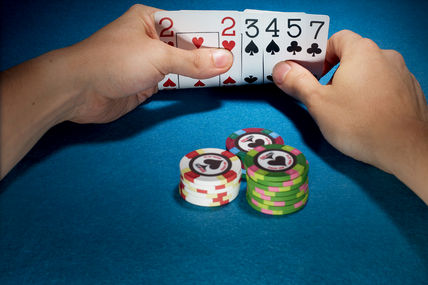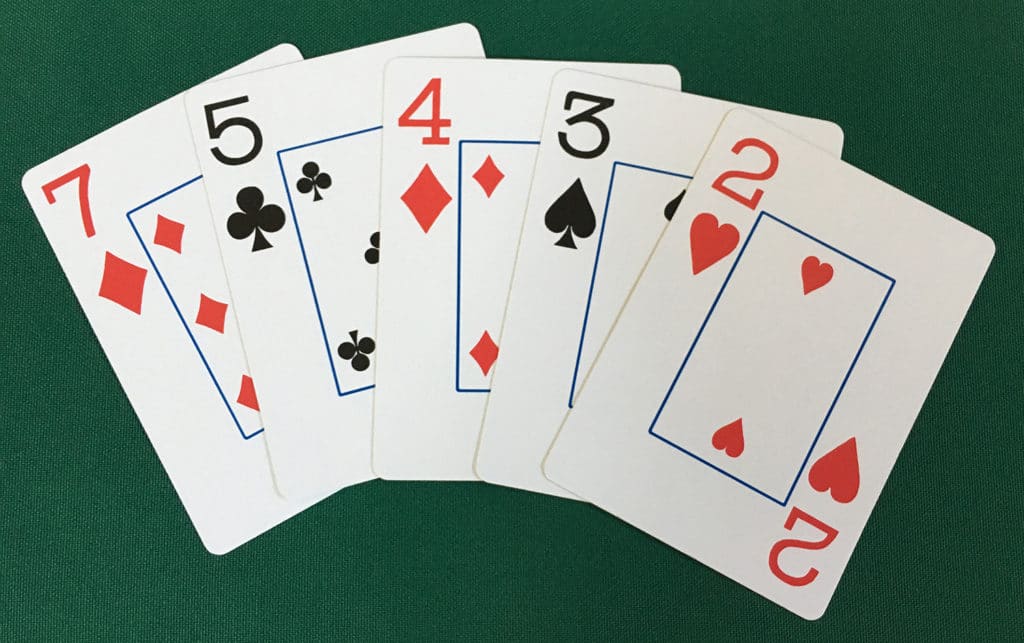Poker 27 Triple Draw

2-7 Triple Draw is a form of ‘lowball’ draw poker. Until recently, the game wasn’t particularly popular but thanks to it’s introduction at various online poker sites and it presence in some mixed game rotations, the player base for this variant has grown in recent years. In fact, 27 Triple Draw is now one of the most popular games among nosebleed stakes players like Phil Galfond and Gus Hansen.
2-7 (Deuce to Seven) Triple Draw. 2-7 (Deuce to Seven) Triple Draw Lowball is a poker game in which the low poker hand wins the pot at showdown. In other words, it is a form of ‘Lowball’. 2-7 Triple Draw is a form of ‘lowball’ draw poker. Until recently, the game wasn’t particularly popular but thanks to it’s introduction at various online poker sites and it presence in some mixed game rotations, the player base for this variant has grown in recent years.
As mentioned it is a lowball game, meaning the goal is to make the worst possible poker hand. In the 2-7 variant, straights and flushes count against a player making a low hand and Aces play high only, so the best possible 2-7 hand is 2-3-4-5-7. This is not the case in A-5 Triple Draw where A-2-3-4-5 would be the best hand.
Some players have trouble in figuring out which lowball hand wins. An easy way to figure it out is to arrange your five cards in descending order and read them out as a five digit number. The hand which makes the lowest five digit number wins, so for example a player holding 2-5-4-6-9 would beat a player holding 2-7-5-4-9 because 96543 is lower than 97543.
Playing a 2-7 Triple Draw Hand
Like Texas Holdem, 2-7 Triple Draw is played with ‘blinds’. Before the hand starts the two players to the left of the dealer are forced to place blind bets, before they see their cards. The player to the dealer’s left places the ‘small blind’ while the player to his left places the ‘big blind’ which is typically twice the small blind. 2-7 TD is normally played with fixed betting limits. On the first two betting rounds, players must bet or raise a fixed amount, known as the ‘small bet’ (usually equal to the big blind amount); while on the latter two rounds the betting increment is the ‘big bet’, normally twice the small bet. The action is usually capped on each round to a maximum of one bet and three raises.

Once the blinds have been placed, the action begins with each player being dealt five cards, one at a time starting with the small blind and going in a clockwise direction. The player to the left of the big blind opens the action; he may either call the amount of the big blind, raise to twice the big blind, or fold (give up on the hand). The action proceeds around the table to the big blind. If there are callers in front of him, he may ‘check’ moving the hand along or raise. He may also call, raise or fold if there has been a raise by an earlier player. If the hand is folded around to the big blind, he wins the pot. If at any point in the hand a player makes a bet or raise which no player calls, they win the pot.
If 2 or more players remain in the hand, we move on to the first drawing round. The dealer moves clockwise around the table starting with the small blind and each player may replace as many of his cards as he pleases. When all remaining players have made their drawing decisions, we move to the second betting round.
This round (and all subsequent rounds) begins with the small blind who may check, passing the action to the next player, or bet. The remaining players may then call, raise or fold if a player in front of them bets.
After the second betting round, there is another drawing round where players may again replace as many of their cards as they please in an effort to replace them with lower cards. After this draw there is a further betting round as was the case after the first draw, however in this instance the betting increment is changed to the big bet.
The action concludes with a final drawing round, followed by a fourth and final betting round, which follows the same pattern as the previous rounds.
If there are players remaining in the hand after the final betting round, the hand goes to a ‘showdown’ where players must show their cards in order to claim the pot, which is awarded to the player with the best 2-7 lowball poker hand as detailed above. If all players check on the final round the player closest to the small blind in a clockwise direction must show first and so on. If there has been betting action on the final round, the final aggressor must show first.

Gameplay of 2-7 Triple Draw Poker
Setting Up
- You'll need: a button, small & big blinds (similar to Texas Hold'em).
- Deal each player 5 cards, face down.
- Use a limit betting structure (such as $3/$6)
The Action
- Action starts to the left of the big blind. You may fold, call or raise.
- After the 1st betting round, draw 0-5 cards. Then betting resumes to the left of the button.
- A total of three draws occur.
Determining a Winner
- Worst possible hand wins, so the best hand is the wheel: 2-3-4-5-7, offsuit.
- Note: straights and flushes DO count against you in this game, and aces play as high only.
- The player with the worst hand scoops the pot. In the event of a tie, the pot is split.

Basic Strategies of 2-7 Triple Draw Poker
Pre-Draw
Like most poker games with a button, position is a big factor in 2-7 Triple Draw.
Knowing how many cards your opponent draws before you is key to formulating your strategy.
Consider adjusting the number of cards you draw based on your opponent's play.
Drawing
As a general rule, you should fold if you must draw more than 2 cards in the early drawing rounds.
Never draw 3 cards on the first draw, unless you get a free draw or you start with exactly 2 and 7 in your hand
Think about folding if you must draw more than 1 card in the later drawing rounds.
Betting
Betting takes place before the first draw and after each draw. If you draw fewer cards than your opponent, you can generally bet out before the next draw.
There is no such thing as slow-playing a big hand since your opponent will see how many cards you take before the next betting round.
What You Need to Know About 2-7 Triple Draw Starting Hands
Poker 27 Triple Drawer
Good Starting Hands
Play these hands in all positions (and for a raise):
- All pat hands of 9 or better
- All 4-card hands of 8 or better.
- All 3-card hands containing wheel cards.
Poor Starting Hands
Never play these hands:
- All hands with three cards valued 8 or above (except for hands containing exactly a 2 and a 7).
- All hands with 0 or 1 wheel cards (2-3-4-5-7).
Marginal Starting Hands
Play these hands cheaply:
- All two card hands containing exactly a 2 and a 7.
Positional Hands
Play in late position when folded to you:
- On the button and hand contains two wheel cards and an 8 (occasionally a 9 depending on the blinds)
- In the small blind play any three card hands containing two wheel cards and an 8 or 9
Do's and Don'ts for Better 2-7 Triple Draw Play
Never Limp Early
Because position is so important, you should never limp into a pot in early position.
Try Getting Heads-up
Playing heads-up pots in position is important. Try to reduce the number of players to two by 3-betting hands early.
Don't Bluff
Bluffing (also called snowing) should be reserved for advanced players, and even then, rarely used. This is good advice for all limit-type-games.
Famous 2-7 Poker Hands
2-7 Single Draw Poker : Action from the 2004 WSOP
Big name players including Barry Greenstein, Howard Lederer, and Chris Ferguson play at the 2004 final table of the WSOP Kansas City Lowball event.
This Video Contains:
- Ferguson doubles up an amateur, 'Jesus heals another cripple'.
- Standard banter among the big names.
- A brief history of 2-7 Triple Draw.
2-7 Triple Draw Poker : Action from a High Stakes Cash Game
Big name players including Gus Hansen, and Tom Dwan play a $1500/$3000 limit 2-7 cash game on the old Full Tilt.
This Video Contains:
- Pots in excess of $30,000 USD.
- Multiple hands which contain all 3 draws.
- Note: This video has no sound.
Where Can I Play 2-7 Triple Draw Online?

Poker 27 Triple Drawing
Try for Free:
Play for Real Money: